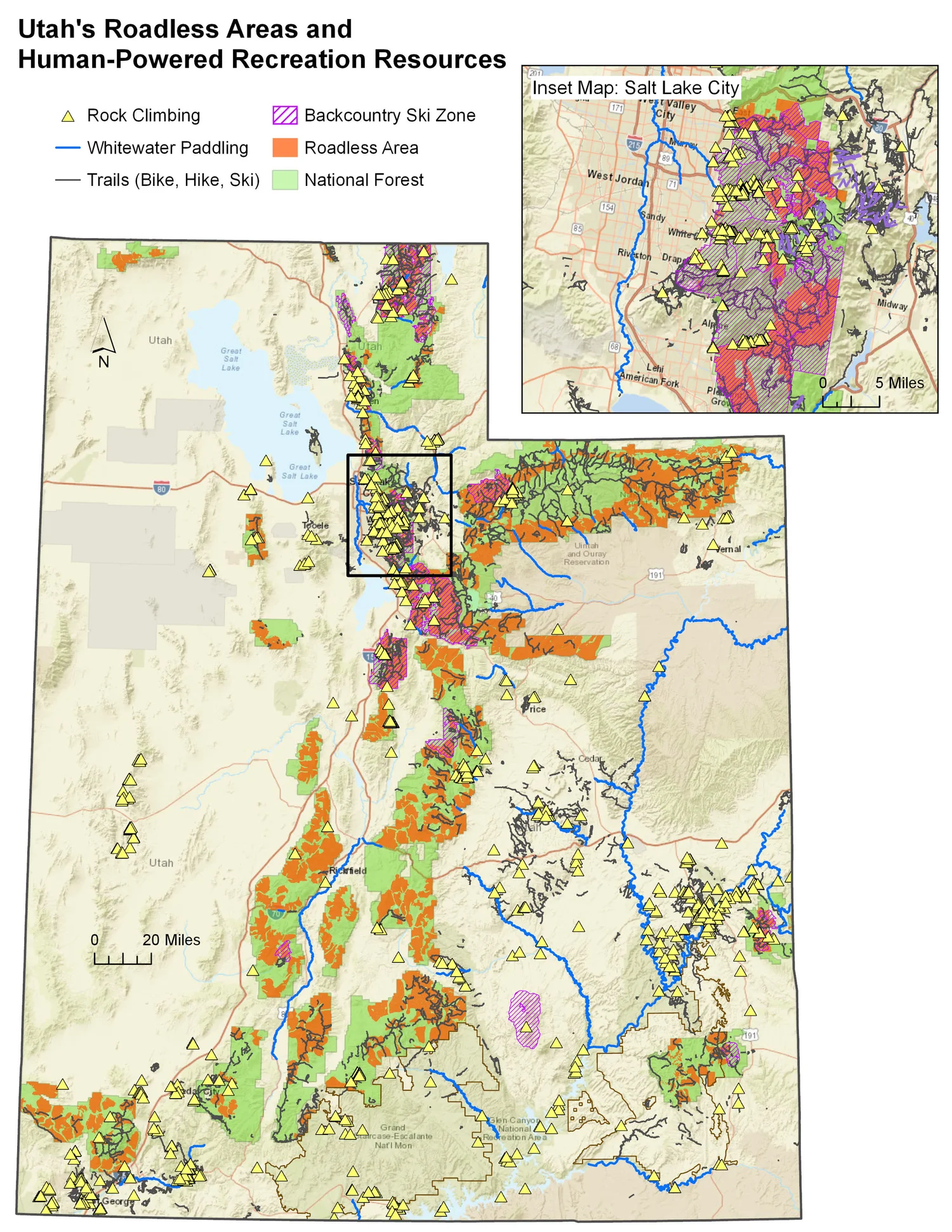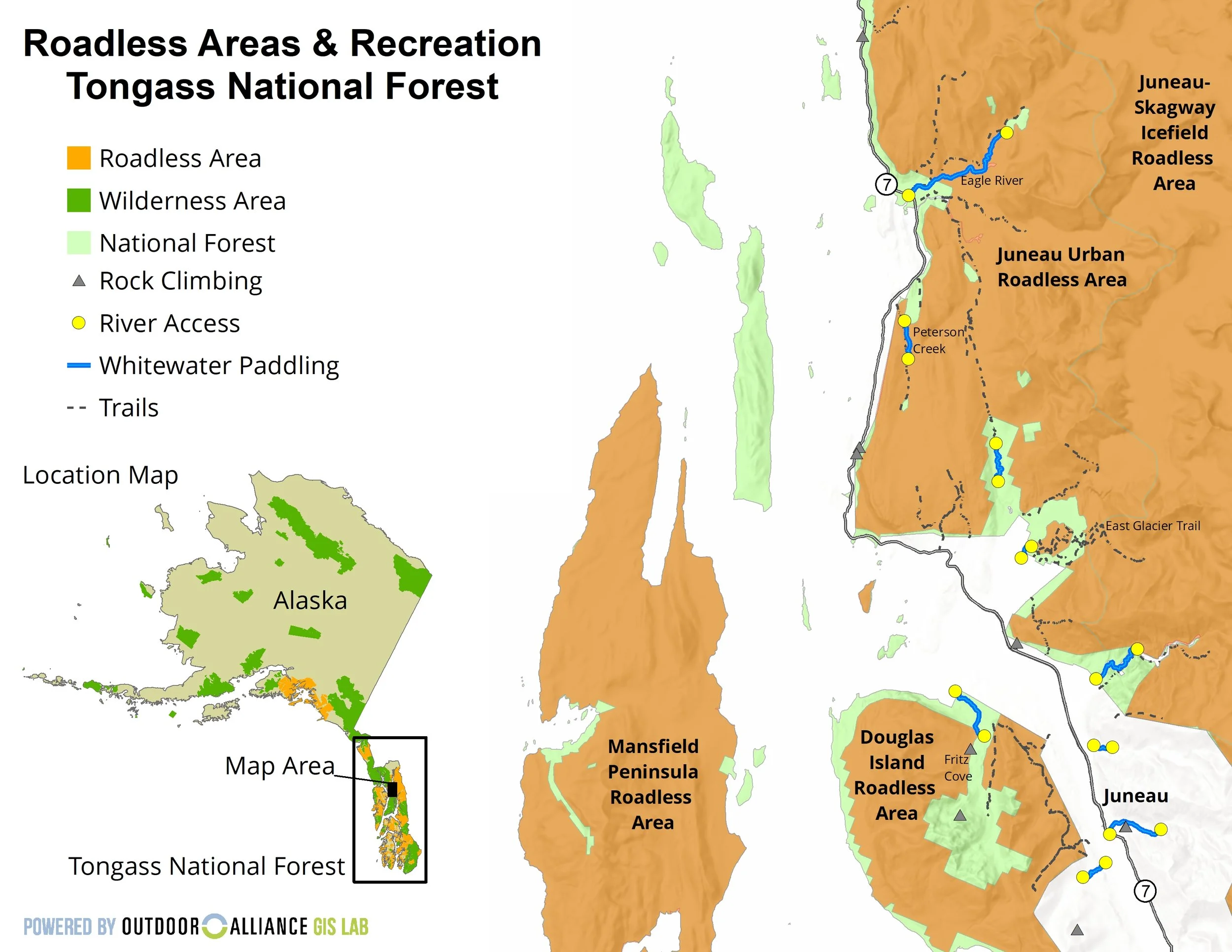Rolling back the Roadless Rule won't increase accessibility for disabled people
- Madeleine
- Aug 11
- 9 min read
Updated: Aug 29
UPDATE: As of August 27th, 2025, the Trump administration is officially attempting to overturn the Roadless Rule. The public comment period is now open, so please make your voices heard in defense of preserving the Roadless Rule!
This post aims to share some more information about the Roadless Rule and clear up some misconceptions. People are asking: Wouldn't more roads in wilderness areas increase accessibility for people with disabilities? While the intention to improve access to the outdoors is a noble one, this idea oversimplifies the reality for disabled outdoor enthusiasts and completely overlooks the true barriers to accessibility. To put it simply, the Roadless Rule being overturned would not increase accessibility to the outdoors for disabled people.
TL;DR ⬇️
More roads don't equal better access: Adding roads to wilderness areas doesn’t guarantee accessibility for disabled individuals. What’s needed are accessible trails, adaptive facilities, and proper infrastructure.
The Roadless Rule protects vital wilderness: Rolling back the Roadless Rule risks industrial development, harming ecosystems, and reducing the quality of outdoor spaces, including those needed for inclusive recreation.
Focus on thoughtful infrastructure: The real solution is investing in accessible trails, campsites, and transportation, not just new roads. Preserving roadless areas supports future development of truly accessible spaces.
Speak up NOW! Public comment period is open until Sept. 19th. Defend the Roadless Rule today!

What is the Roadless Rule, and what does it really protect?
When Trump took office in January 2025, Agriculture Secretary Rollins announced plans to roll back the 2001 Roadless Rule, a decision that holds major implications for our National Forests here in the United States.
If the rule is eliminated, it would remove vital protections for 58 million undeveloped acres of National Forest, opening the door for industrial logging and road construction that would harm these pristine areas.
“The Roadless Rule has safeguarded 58 million acres of our most untouched national forest lands from clearcutting for decades,” said Drew Caputo, Vice President of Litigation for Lands, Wildlife, and Oceans at Earthjustice. “Now, the Trump administration wants to dismantle these protections to allow the timber industry to profit from unchecked logging.”
What does the Roadless Rule do?
The Roadless Rule doesn’t just prevent roads from being built in national forests—it plays a crucial role in protecting the wilderness areas that remain free from industrial activity, which is vital for the environment and the future.
The Roadless Rule protects 58 million acres of National Forests across 38 states, and it's one of the most successful conservation policies in U.S. history. Its primary purpose is to prevent roads from being built in "Roadless Areas," which are remote, undeveloped parts of forests that are ideal for outdoor recreation.
More roads ≠ more recreation: Roads may seem like an easy way to "open up" access, but they often don’t lead to trails, campsites, or viewpoints that disabled people can use. Adding roads doesn’t mean you get infrastructure like accessible trails or amenities. Roads alone won't make wilderness spaces usable without the necessary adaptive features—features that require careful planning, design, and investment. There are zero plans for this right now.
Wilderness areas for future access: Rolling back the Roadless Rule doesn’t mean more recreational areas—it means more industrial activity like logging and drilling, which often harms natural landscapes and leaves them less suitable for all types of outdoor recreation, including for disabled individuals. What we need is better access to what’s already protected, not the destruction of the very wilderness that could be developed for inclusive recreation in the future.
The Roadless Rule has already safeguarded 11,337 rock climbing routes, 43,826 miles of hiking trails, and over 20,000 miles of mountain biking trails. If we want accessible recreation, the solution isn’t more roads, it’s better, more thoughtful development of existing and protected spaces.
Introducing more roads into roadless areas could actually diminish the wilderness experience for people of all abilities, including those with disabilities. Roads disrupt natural ecosystems, contribute to habitat fragmentation, and often lead to the destruction of pristine areas that many outdoor lovers, including disabled individuals, value. This can actually create more challenges than solutions for those seeking a peaceful and undisturbed environment.
Additionally, roads in wilderness areas may not be properly maintained or accessible to people with mobility challenges. Roads can become rugged, poorly paved, or inaccessible in extreme weather, especially in remote wilderness areas where resources are limited. Even in areas with roads, many of these roads still require specialized vehicles like four-wheel drives or ATVs to access, rather than regular vehicles. Having roads doesn’t mean they’re even necessarily accessible by a standard car. And again, road access alone does not guarantee accessibility—what matters more are the adaptive features like accessible pathways, campgrounds, and transportation services.
Common misconceptions about the Roadless Rule
🚫 MYTH: Removing the Roadless Rule will help with wildfire management.
✅ TRUTH: Removing the Roadless Rule could actually increase the likelihood of fires in these areas.
While there are forest management strategies that incorporate ethical logging to reduce the likelihood and severity of fires, opening these lands up to the development of more roads is not in alignment with these strategies.
While it’s true that forest fires have been a growing concern, it’s important to understand that the cause of these fires is multifaceted. Wildfires are influenced by climate change, forest management practices, and yes, sometimes lack of proper thinning or maintenance in areas that are left untended. However, rolling back the Roadless Rule won’t necessarily help with wildfire management. In fact, roads and logging often disrupt the natural resilience of forests, making them more susceptible to fire. The key is a balance of management that maintains forest health without compromising their integrity.
Rolling back protections could open the door to practices that harm the forest’s long-term health, potentially exacerbating the issue.
🚫 MYTH: The Roadless Rule means more non-managed land, which is dangerous and unproductive. We need maintenance.
✅ TRUTH: These forests are not just untouched, unmanaged wilderness. They support a range of wildlife, provide clean water, and act as vital carbon sinks.
Logging and road construction may seem like immediate solutions for forest health, but they disrupt ecosystems that have evolved to be free of such disturbances. The Roadless Rule has been a critical tool in protecting over 58 million acres of our wildest lands. Many of the people opposing the rollback have a deep understanding of these impacts and are advocating for sustainable practices that balance conservation and forest management.
Maintenance is important for the health of our forests. However, simply adding roads and increasing access doesn’t automatically lead to better forest management. Removing the Roadless Rule doesn’t automatically add in any requirements for ethical management or environmental protection.
The issue isn’t just about road maintenance. It’s about what comes with new roads, like increased industrial activity (logging, mining) that can damage ecosystems. Instead of opening up more roads, we should be focusing on smart, adaptive management strategies that incorporate thinning, prescribed burns, and ecosystem restoration, without opening the door for irreversible damage to protected areas.
Many tribal lands have found effective forest management techniques, but that’s not what will happen if we reverse this rule. While selective logging and prescribed burns can be beneficial in some contexts, this doesn’t mean that we should open up all roadless areas to logging. The Roadless Rule was established to protect some of the most pristine, ecologically sensitive areas in our national forests. It’s about preserving the integrity of these wild lands while promoting responsible, science-based management strategies that do not threaten their unique ecosystems. The goal is to find the right balance, not to abandon protections that safeguard wilderness areas.
🚫 MYTH: Removing the Roadless Rule would open up wilderness spaces for disabled people
✅ TRUTH: Simply adding roads does not guarantee that people with disabilities will be able to enjoy these spaces
Accessibility isn’t about roads; it’s about having the proper infrastructure, services, and support to ensure everyone can experience and enjoy the outdoors. More on this in the next section below.
The real barriers to wilderness access for disabled people
Roads do not mean accessibility. According to a report by The National Park Service's Accessibility in the National Parks, only 15% of the over 400 parks in the U.S. have fully accessible trails. Even in our National Parks, there’s a significant gap in accessible infrastructure despite the presence of roads.
"Roads are often seen as the simple solution, but without accessible pathways and proper facilities, roads alone don’t make our parks usable for all.” - National Park Service
Instead of focusing on building more roads, we should be advocating for thoughtful investments in accessible infrastructure that truly makes a difference for disabled adventurers.
Some of the most common barriers disabled people face in accessing outdoor spaces are not related to the presence of roads, but rather the lack of:
Accessible trails: Smooth, wide trails with proper surfaces for wheelchairs, scooters, or other mobility devices.
Adaptive recreation areas: Camping sites with flat surfaces, wheelchair-accessible restrooms, and wide picnic areas.
Transportation services: Accessible shuttles or transportation options to take people from parking areas to trailheads or other areas of interest.
Signage and information: Clear, accessible signage that helps people navigate trails and areas based on their specific needs, including sensory accommodations for those with hearing or visual impairments.
The focus should be on improving existing infrastructure and creating spaces where everyone can feel comfortable, regardless of their abilities.

Roads ≠ Accessibility for disabled people
The assumption that roads automatically improve access for disabled individuals is a widespread myth. Simply adding roads does not guarantee that people with disabilities will be able to enjoy these spaces. Accessibility isn't just about getting to a location; it's about having the proper infrastructure, services, and support.
For many disabled individuals, the type and quality of access is far more important than just having a road. It's not the presence of roads that makes the outdoors more accessible, but the adaptations and design of those spaces to accommodate mobility aids like wheelchairs, power scooters, and other assistive technologies. Accessible trails, properly designed campsites, and suitable facilities are what truly matter—none of which are guaranteed by simply allowing more roads into wilderness areas.
Some examples of accessible design below.
What's next for the roadless rule: How you can help protect it
Nothing is final yet, so please don’t use this section as a 150% accurate source of information. If we know anything about the way the Trump admin works, things change by the hour, and this information could become outdated quickly. Here’s the latest:
Rough timeline for the Roadless Rule
Formal rulemaking process: The U.S. Department of Agriculture (USDA) has reviewed the Roadless Rule and aims to rescind it. This involved a series of steps, including drafting a new rule, conducting environmental reviews, and allowing for public comment. The exact timeline can vary, but it's important to stay informed as the process progresses.
WHERE WE ARE NOW: Public comment period. During this time (until September 19th), individuals and organizations can submit feedback supporting the retention of the Roadless Rule. Past comment periods have seen overwhelming support for the rule, with nearly 1.6 million comments submitted during its original adoption in 2001. THIS IS YOUR TIME TO ACT! Leave a comment here!
Legal challenges: If the rule is rescinded, it's anticipated that legal challenges will follow. Environmental groups and stakeholders have historically been active in defending the Roadless Rule through litigation. Time will tell here.
What we can do to protect the Roadless Rule
Unfortunately, there’s not much we can do right in this moment aside from continuing to keep our finger on the pulse and be ready to act when the time comes.
Submit public comments: Submit comments expressing your support for maintaining the Roadless Rule. You can do so here until Sept. 19th. Please be sure to write your own unique comment when the time comes - do not copy/paste comments from anyone else. It’s important to tell your story and use your own words.
Engage with legislators: Contact your elected representatives to voice your support for the Roadless Rule. Encourage them to oppose any efforts to rescind the rule and to advocate for the protection of our National Forests.
Stay informed and spread awareness: Keep up to date with developments regarding the Roadless Rule. Share information with your community and networks to raise awareness about the importance of protecting these lands.
Support advocacy organizations: Consider supporting organizations that are actively working to protect the Roadless Rule through legal action, public campaigns, and policy advocacy. Groups like Earthjustice, Outdoor Alliance, and The Wilderness Society are at the forefront of these efforts.
By staying informed and actively participating in the public process, you can play a crucial role in helping to protect the Roadless Rule and the invaluable landscapes it safeguards.
TL;DR: The wilderness is for everyone, but it needs to be thoughtfully managed as well
The wilderness is meant to be a space of refuge, exploration, and respect for the natural world. For disabled people (as with all outdoor enthusiasts), it’s not about roads—it’s about ensuring that the experience of being outdoors is inclusive and enjoyable. By preserving roadless areas, we ensure that these precious lands remain undisturbed and protected while we focus on developing truly accessible spaces in the right places.
Rolling back the Roadless Rule could do the opposite of what we want. It could harm the very landscapes that have the potential to become models of accessible and sustainable outdoor recreation. Instead, we need to advocate for a vision of the outdoors that prioritizes thoughtful design, inclusivity, and respect for both nature and people of all abilities.
SPEAK UP TODAY! Leave a comment in support of preserving the Roadless Rule before Sept. 19th.













Comments